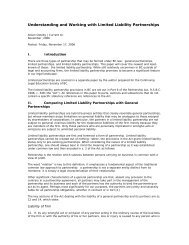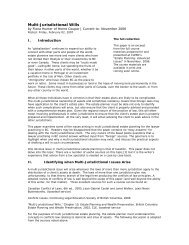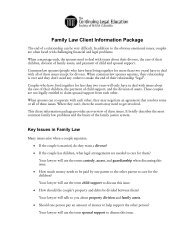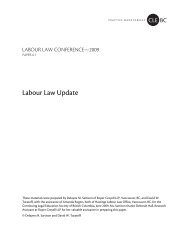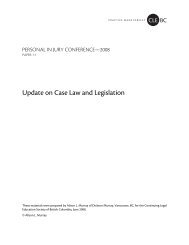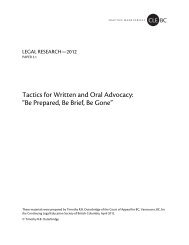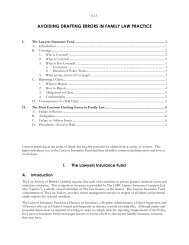Joint Ventures-The Limited Fiduciary Relationship Structure
Joint Ventures-The Limited Fiduciary Relationship Structure
Joint Ventures-The Limited Fiduciary Relationship Structure
You also want an ePaper? Increase the reach of your titles
YUMPU automatically turns print PDFs into web optimized ePapers that Google loves.
5.1.4<br />
Central Mortgage has been followed in BC. In Canlan, Tysoe J. (as he then was) accepted as a correct<br />
proposition of law that a joint venture must have a contractual basis.<br />
<strong>The</strong> existence of a contractual underpinning was also the issue in the recent case of Zynik Capital Corp.<br />
v. Faris, 2007 BCSC 527. Zynik and Intergulf, an investment company, agreed to jointly pursue an<br />
opportunity to purchase the Versatile Shipyards in North Vancouver. <strong>The</strong> parties signed a<br />
memorandum of understanding describing the basic terms of the venture pending the execution of a<br />
formal agreement.<br />
<strong>The</strong> MOU specified a date on which the joint venture would end if the acquisition did not occur.<br />
Negotiations ensued with the bank holding security over the property. Intergulf took responsibility<br />
for finalizing the negotiations. A few days before the closing date, a dispute arose between the parties<br />
and Intergulf decided to acquire the property for itself. However, Intergulf failed to close the<br />
transaction and the bank sold the property to a third party.<br />
Zynik sued, claiming that Intergulf breached its obligations arising from the joint venture allegedly<br />
created by the memorandum. Tysoe J. held that the joint venture described in the memorandum was<br />
not a binding contract for two reasons: first, the parties had not agreed on the price they would pay<br />
for the asset, and had not even agreed on a maximum price they would be willing to bid for the asset;<br />
and second, even if the price had been agreed, Intergulf would not have been bound because it had<br />
reserved the right to conduct due diligence on the property. By implication, Intergulf would not have<br />
been bound to proceed with the transaction if it was dissatisfied with the results of its due diligence.<br />
Because the parties had failed to agree on essential terms, their arrangement amounted to an agreement<br />
to agree, which is not enforceable. To be a good contract there must be a concluded bargain, and a<br />
concluded contract is one which settles everything that is necessary to be settled and leaves nothing to<br />
be settled by agreement between the parties.<br />
C. Distinguishing a JV from a Partnership<br />
1. <strong>Fiduciary</strong> Duties Uncertain<br />
Partnerships are presumptively fiduciary relationships at common law. Section 22 of the Partnership<br />
Act (BC) imposes on partners the additional duties of utmost fairness and good faith in their conduct<br />
toward one another. By contrast, judicial opinion is divided on the issue of whether joint venture<br />
agreements presumptively create fiduciary relationships (Cadbury Schweppes Inc. v. FBI Foods Ltd.,<br />
[1999] 1 S.C.R. 142, 167 D.L.R. (4th) 577; Visagie v. TVX Gold Inc. (2000), 187 D.L.R. (4th) 193, 132<br />
O.A.C. 231) which are further discussed below.<br />
While courts have long been reluctant to impose fiduciary duties in the context of commercial<br />
agreements the quasi-partnership nature of the JV has cases going each way. <strong>The</strong> governing principle<br />
for no fiduciary obligations in the context of sophisticated commercial negotiations was stated by<br />
Wilson J. in her dissenting reasons in Frame v. Smith, [1987] 2 S.C.R. 99. However, some decisions<br />
have found fiduciary obligations presumptively exist (see First Madison Corp v. Shabinsky, [1992] O.J.<br />
No. 2117 (C.A.), Finlayson J.A., relying in part upon Wonsch, also concluded that a joint venturer<br />
owed fiduciary duties to co-venturers. Also: Reichmann v. Vered, [2003] O.J. No. 1029 (Sup.Ct.).)<br />
a. <strong>The</strong> Taxman’s View<br />
<strong>The</strong> Excise Tax Act Guidelines 8 (the “Guidelines”) provide a useful discussion as to the Canadian federal<br />
government’s views of the common law principles that distinguish a JV from a partnership. Under<br />
the Guidelines it is noted that both partnerships and JVs must comprise of two or more parties. It is<br />
8 GST Law reporter, CGST 156c (2002-11-15).




